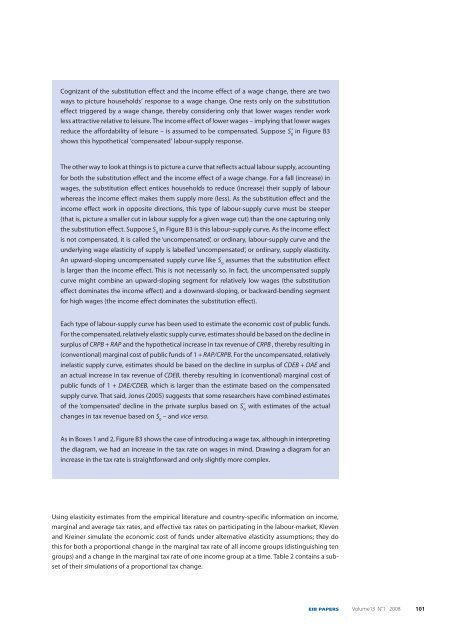EIB Papers Volume 13. n°1/2008 - European Investment Bank
EIB Papers Volume 13. n°1/2008 - European Investment Bank
EIB Papers Volume 13. n°1/2008 - European Investment Bank
You also want an ePaper? Increase the reach of your titles
YUMPU automatically turns print PDFs into web optimized ePapers that Google loves.
Cognizant of the substitution effect and the income effect of a wage change, there are two<br />
ways to picture households’ response to a wage change. One rests only on the substitution<br />
effect triggered by a wage change, thereby considering only that lower wages render work<br />
less attractive relative to leisure. The income effect of lower wages – implying that lower wages<br />
reduce the affordability of leisure – is assumed to be compensated. Suppose S * in Figure B3<br />
0<br />
shows this hypothetical ‘compensated’ labour-supply response.<br />
The other way to look at things is to picture a curve that reflects actual labour supply, accounting<br />
for both the substitution effect and the income effect of a wage change. For a fall (increase) in<br />
wages, the substitution effect entices households to reduce (increase) their supply of labour<br />
whereas the income effect makes them supply more (less). As the substitution effect and the<br />
income effect work in opposite directions, this type of labour-supply curve must be steeper<br />
(that is, picture a smaller cut in labour supply for a given wage cut) than the one capturing only<br />
the substitution effect. Suppose S in Figure B3 is this labour-supply curve. As the income effect<br />
0<br />
is not compensated, it is called the ‘uncompensated’, or ordinary, labour-supply curve and the<br />
underlying wage elasticity of supply is labelled ‘uncompensated’, or ordinary, supply elasticity.<br />
An upward-sloping uncompensated supply curve like S assumes that the substitution effect<br />
0<br />
is larger than the income effect. This is not necessarily so. In fact, the uncompensated supply<br />
curve might combine an upward-sloping segment for relatively low wages (the substitution<br />
effect dominates the income effect) and a downward-sloping, or backward-bending segment<br />
for high wages (the income effect dominates the substitution effect).<br />
Each type of labour-supply curve has been used to estimate the economic cost of public funds.<br />
For the compensated, relatively elastic supply curve, estimates should be based on the decline in<br />
surplus of CRPB + RAP and the hypothetical increase in tax revenue of CRPB , thereby resulting in<br />
(conventional) marginal cost of public funds of 1 + RAP/CRPB. For the uncompensated, relatively<br />
inelastic supply curve, estimates should be based on the decline in surplus of CDEB + DAE and<br />
an actual increase in tax revenue of CDEB, thereby resulting in (conventional) marginal cost of<br />
public funds of 1 + DAE/CDEB, which is larger than the estimate based on the compensated<br />
supply curve. That said, Jones (2005) suggests that some researchers have combined estimates<br />
of the ‘compensated’ decline in the private surplus based on S * with estimates of the actual<br />
0<br />
changes in tax revenue based on S – and vice versa.<br />
0<br />
As in Boxes 1 and 2, Figure B3 shows the case of introducing a wage tax, although in interpreting<br />
the diagram, we had an increase in the tax rate on wages in mind. Drawing a diagram for an<br />
increase in the tax rate is straightforward and only slightly more complex.<br />
Using elasticity estimates from the empirical literature and country-specific information on income,<br />
marginal and average tax rates, and effective tax rates on participating in the labour-market, Kleven<br />
and Kreiner simulate the economic cost of funds under alternative elasticity assumptions; they do<br />
this for both a proportional change in the marginal tax rate of all income groups (distinguishing ten<br />
groups) and a change in the marginal tax rate of one income group at a time. Table 2 contains a subset<br />
of their simulations of a proportional tax change.<br />
<strong>EIB</strong> PAPERS <strong>Volume</strong>13 N°1 <strong>2008</strong> 101

















